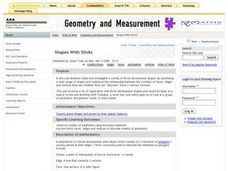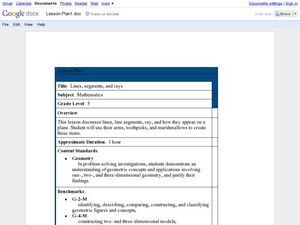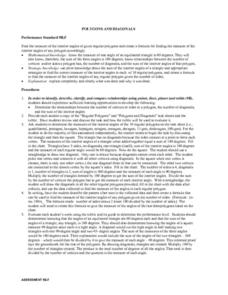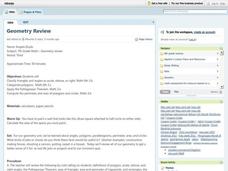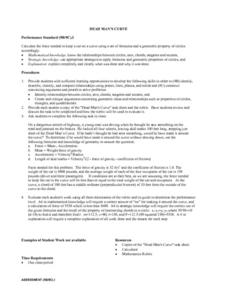Curated OER
An Introduction to Quadrilaterals
Students explore different types of quadrilaterals. Students define the terminology used with quadrilaterals. They create particular quadrilaterals based on specific characteristics of the quadrilaterals using an online tool.
Curated OER
"Geotown" Scrapbook
Students create a scrapbook. In this geometry lesson, students use digital cameras to take pictures of geometrical concepts. Students use the pictures to create a "Geotown" scrapbook.
Curated OER
Shapes
In this shapes worksheet, learners identify shapes according to sentences that describe them. Students identify 8 shapes, but have 14 to choose from.
Curated OER
Shape Detectives
Students become "shape detectives" as they identify, name, create and describe common shapes within pictures and objects found within the learning environment. Suggestions include incorporating shapes into all learning areas and daily...
Curated OER
What a Shape!
Second graders culminate their study of shapes by describing the shapes using the proper mathematical descriptors.
Curated OER
Shapes with Sticks
Third graders investigate three dimensional shapes. They examine a variety of shapes and the relationship between the number of faces, edges, and vertices. Students determine Euler's formula and they create a variety of three dimensional...
Curated OER
Natural Figures
First graders look for geometrical shapes in nature to help them appreciate the diversity of the natural environment.
Curated OER
Lines, Segments, and Rays
Fifth graders use their arm, toothpicks, and marshmallows to create lines, segments, and rays. In this lines, segments, and rays lesson plan, 5th graders learn how these appear on a plane.
Curated OER
Plane Figures
Fifth graders create polygons requested by their teacher. In this polygons lesson, 5th graders watch a video and listen to a song about polygons. Then, students take turns labeling various polygons and practice making polygons.
Curated OER
Review Geometry Week
Fifth graders participate in a review game of geometry topics. In this geometry lesson, 5th graders use the "Eggspert" interactive classroom game system to review the geometry skills taught that week. Students work in teams to complete...
Curated OER
Polygons and Diagonals
Students practice measuring the interior angles of given regular polygons and create a formula for finding the measure of th interior angles of any polygon. They determine the relationships between the number of vertices's or sides in a...
Curated OER
Geometry Review
Seventh graders explore basic geometric definitions involving angles, area, and circumference. To reinforce basic geometric concepts, they play a "lightning Flash" card game. Students discuss chores or jobs that require the use of...
Curated OER
Volume, Surface Area for Rectangular & Triangular Prisms
Seventh graders explore the concept of rectangular and triangular prisms. In this rectangular and triangular prism instructional activity, 7th graders identify various prisms as triangular or rectangular. Students discuss the various...
Curated OER
Geometry Jeopardy
Students identify the pattern in a problem. In this geometry lesson, students make predictions, collect and analyze data. They apply the idea of scales and measurements to the real world.
Curated OER
Shape Up!
Students investigate measurement through the use of literature through this series of lessons.
Curated OER
You're a Pattern and I Know It
Students listen to Green Eggs and Ham by Dr. Seuss, then identify the patterns.
Curated OER
Translations, Reflections, and Rotations
Students are introduced to the concepts of translation, reflection, and rotation. They practice translating, reflecting, and rotating two-dimensional objects on the coordinate plane. students use computers to learn about the three concepts.
Curated OER
DEAD MAN'S CURVE
Ninth graders, after being given a unique scenario and a task sheet on Dead Man's Curve, calculate and explain the force needed to keep a car on a curve using a set of formulas and a geometric property of circles. They utilize and create...
Curated OER
Identify Plane Shapes and Solid Shapes
First graders explore the math concept of geometric shapes. For this plane shapes and solid shapes lesson, 1st graders examine visual examples. Students also practice solving problems that their instructors model.
Curated OER
Build a Weather Vane
Students construct a weather vane using their knowledge of some geometric shapes. In this weather instructional activity, students work in pairs to create a weather vane in order to measure wind direction. Students follow...
Curated OER
Mandalas : polygons
Fourth graders create mandalas. In this mandala lesson plan, 4th graders look at these polygons in nature and man-made forms. They create their own by using tangrams.
Curated OER
Surface Area with Polydrons
Students explore measurements by analyzing geometric shapes. In this surface area lesson, students identify the terms volume, weight, perimeter and area in order to find the requested measurements of specific polygons. Students utilize...
Curated OER
Interior and Exterior Angles of Polygons
Students identify interior and exterior angles of polygons. In this geometry instructional activity, students add interior and exterior angles of polygons. They use angle theorems to solve the problems.
Other popular searches
- Classifying Triangles
- Classify Triangles
- Classifying Triangles Quiz
- Geometry Classify Triangles
- Classify Triangles by Sides
- Classify Triangles by Angles
- Classifying Angles Triangles
- Classify Triangles Problem
- Classifying Triangles by Sides








